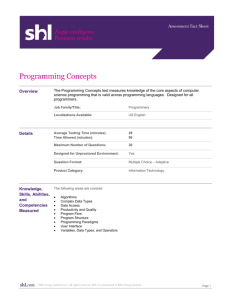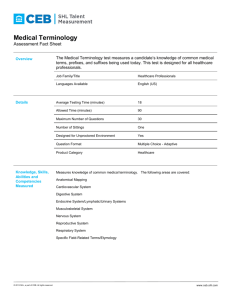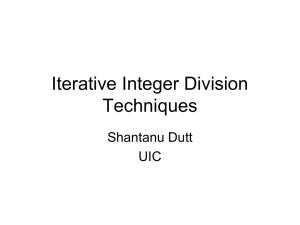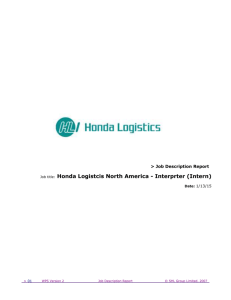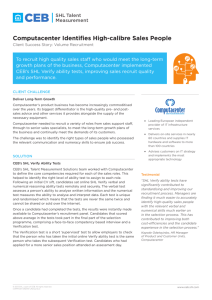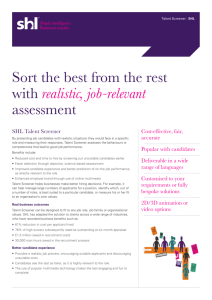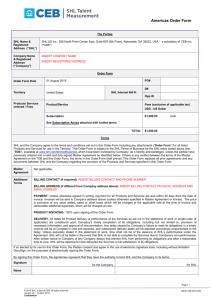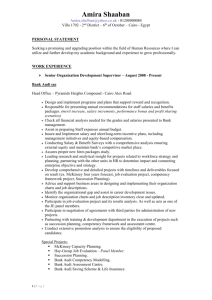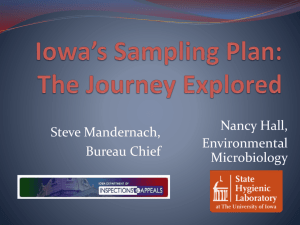SHL Group Ltd
advertisement
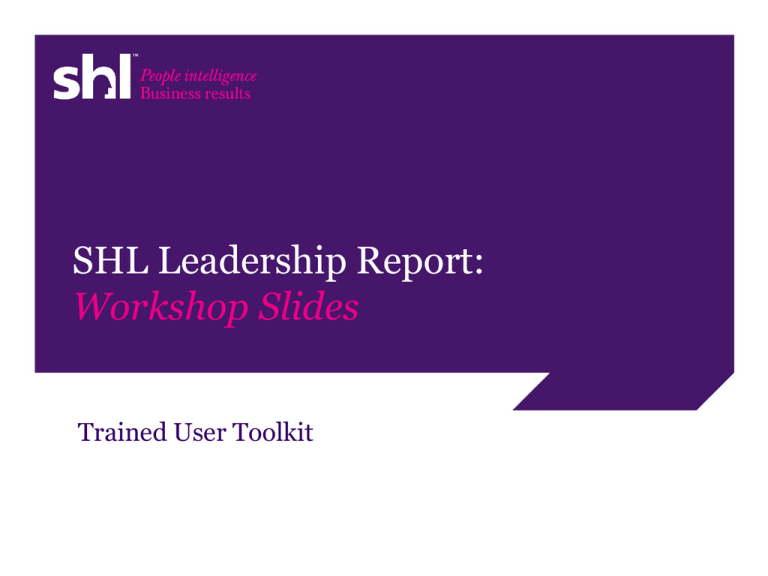
SHL Leadership Report: Workshop Slides Trained User Toolkit www.shl.com INTRODUCTION 2 © SHL, 2011 How to use this slide deck: • Use as a resource to support you when practically applying the SHL Leadership Report in your organisations, alongside the User Guide. • Some of the slides are designed to support you the OPQ trained user in preparing for feedback sessions and/or workshops. These are highlighted as ‘preparation slides’. • The remainder of the slides are designed for you to use with an untrained audience in different contexts. These are highlighted as ‘workshop slides’. • Pick and choose the sections and slides that you require for the context within which you are applying the SHL Leadership Report. – These slides are a toolkit for you to use and a starting point for developing sessions/workshops in your context, they are not intended to be the “finished article”. – Set aside plenty of time to build upon these slides, ahead of any events you may be running. – The slides are aimed at trained OPQ users, who are also experienced in delivering individual and organisational interventions. 3 © SHL, 2011 Contents of this slide deck: • Section 1: What is Leadership? – Use these slides to set the scene around leadership – You may wish to add further slides depending on your specific organisational context • Section 2: Selection – Use these slides when using the Leadership Report to support selection decisions, e.g. feedback to hiring managers in selection situations • Section 3: Individual Development – Use these slides when providing feedback on the Leadership Report to individuals in development situations • Section 4: Organisational Development – Use these slides when providing feedback to individuals and internal stakeholders in organisational development situations • Section 5: Team Development – Use these slides when facilitating a team building session or presenting team results. 4 © SHL, 2011 SECTION 1: WHAT IS LEADERSHIP? Leadership The SHL model 5 © SHL, 2011 Leadership – what is it? “If you’re leading, and no one’s following, you’re just out for a walk.” • John Maxwell “Leading is easy, the hard part is getting people to follow” • Yogi Berra 6 © SHL, 2011 Leadership – what is it? 7 © SHL, 2011 Leadership – what is it? “No theory or model of leadership so far has provided a satisfactory explanation of leadership…indeed there is no consensus on the meaning of leadership in the first place” – Gill, 2006 “Leadership is like gravity. You know it's there, you know it exists, but how do you define it?” – Dr. Jamie Williams, Former San Francisco 49er “There are as many different definitions of Leadership out there as there are people who have tried to define it...” – Bernard Bass 8 © SHL, 2011 Management vs Leadership Transactional Leader Management Where leadership is about keeping the system running efficiently and effectively vs. Transformational Leader Leadership Where leadership is about creating, developing or changing direction 9 © SHL, 2011 What’s the difference between Leadership and Management? • Overly Strong Leadership can: – Disrupt an orderly planning system – Undermine the management hierarchy • Overly Strong Management can: – Discourage risk taking – Minimise enthusiasm for change and progress • Both are needed for an organisation to prosper! 10 © SHL, 2011 Defining Leadership Leadership is about influencing people such that they come to share common goals, values, and attitudes, and work more effectively towards the achievement of the organisation’s vision. An effective leader is one who makes a demonstrable impact on one or more of these criteria in a positive way by influencing the behaviour and performance of others. Dave Bartram, Chief Psychologist, SHL 11 © SHL, 2011 SECTION 1 (cont.): WHAT IS LEADERSHIP? Leadership The SHL model 12 © SHL, 2011 The Functional Leadership Cycle Strategy: the critical analysis of the current situation, and the generation of ideas to move forward. Developing the Vision Sharing the Goals Delivering Success Gaining Support Operations: using operational efficiency and commercial acumen to effectively implement the strategy. 13 Communication: persuasively communicating the vision to others, as well as personally adapting to the changes that the new strategy brings. People: gaining other people’s support by motivating and empowering them to implement the actions needed to deliver the strategy. © SHL, 2011 The SHL Corporate Leadership Model `Transactional : Management Focus Functions Transformational : Leadership Focus Analysing & Interpreting Developing the Vision Creating & Conceptualising Adapting & Coping Sharing the Goals Interacting & Presenting Supporting & Cooperating Gaining Support Leading & Deciding Organising & Executing Delivering Success Enterprising & Performing 14 © SHL, 2011 Leadership Styles Overall Management vs. Leadership Leaders transform Corp. Leaders transform organisations through innovation, drive, persuasive communication and entrepreneurial flair. organisations by integrating the best elements of both Leaders and Managers styles. Contributors focus on Managers are effective tasks within a defined area and use tried and tested approaches to resolve problems. They are likely to feel comfortable taking direction from others. in coping with pressure and driving operational success in the here-andnow. 15 © SHL, 2011 Section 2: SELECTION 16 © SHL, 2011 Section 2.1: PREPARATION SLIDES 17 © SHL, 2011 Prior to the selection event Questions to ask at the beginning of any selection process: • What is the role being selected to? • What competencies are going to be assessed during selection? Do we know? • How much of an understanding do we have of the role and its responsibilities? • Who are the key stakeholders (who will be making the selection decision)? • Which assessment methods will be used? • Where in the process will the SHL Leadership Report be used? E.g. To support the decision making process or inform a competency based interview? 18 © SHL, 2011 Prior to Delivering Feedback Preparation for feeding back the SHL Leadership Report: • Allow 1 hour to review each report and plan your feedback. • Who are you delivering feedback to? The hiring manager? An interview panel? A talent board? Are they OPQ trained? • How long do you have for the feedback session for each candidate? • What kind of output are they looking for? What information do they need? – High level summary of areas of strength and development? – Proposed interview questions in relation to each of the functions within the report? 19 © SHL, 2011 Section 2.2: WORKSHOP SLIDES 20 © SHL, 2011 The Visionary Workshop (with key Stakeholders) 21 © SHL, 2011 Prior to the selection event Visionary Workshop with key senior stakeholders: • What are the strategic aims for the business? • How does the role contribute to the achievement of strategic aims? • What, if any, organisational changes are planned for the next 1-5 years? • How will the role be affected? Will the role holder be required to behave differently in response to these changes in the future? E.g. display a stronger transformational focus? • What are the key role responsibilities NOW? • Is there anything the new job incumbent needs to be doing more of or differently in order to be successful in the future? 22 © SHL, 2011 Leadership Types: Overall Leaders transform organisations through innovation, drive, persuasive communication and entrepreneurial flair. Corp. Leaders transform Management vs. Leadership organisations by integrating the best elements of both Leaders and Managers styles. Contributors focus on tasks within a defined area and use tried and tested approaches to resolve problems. They are likely to feel comfortable taking direction from others. Managers are effective in coping with pressure and driving operational success in the here-andnow. 23 © SHL, 2011 Developing the Vision Creators work well in Visionaries excel in situations requiring openness to new ideas. They typically handle challenges with creativity and will often support or drive organisational change. developing a vision for the organisation while critically evaluating the facts, and creating the ideas and concepts that move the organisation forward. Analysts are naturally suited to critical thinking and quickly get to the heart of complex issues. They work most effectively in situations requiring the application of established methods. Conservators thrive in environments where they can continue to use wellproven methods and discourage incompatible ideas. 24 © SHL, 2011 Sharing the Goals Communicators present a Change Ambassadors convincing case for the new vision and strategy. They enjoy public speaking, network effectively and are generally successful in persuading and influencing others. flourish on pressure and change and inspire others to share the organisation’s new vision and goals. They relate to others in a confident, relaxed manner and network effectively. Stability Seekers thrive in Adjusters focus on the stable environments and prefer informal channels of communication. Their focus on more negative aspects of a situation could help highlight potential issues. positive aspects of the new vision and strategy, and respond well to the challenges it brings. 25 © SHL, 2011 Gaining Support Decision Makers People Leaders listen to naturally seek to take control. They prefer not to engage with the personal concerns of others, which may make it easier for them to make hard choices impacting other people. other people’s views, and know how best to motivate others, which helps them to gain other people’s trust. They naturally prefer to take control. Individualists are more Team Players naturally put strongly focussed on taskrelated than on people-related aspects of the job. They are open in expressing their own opinions and may seek to take an independent advisory role within the group. people issues first, supporting colleagues and showing respect towards others. They understand how to motivate other people and gain their support. 26 © SHL, 2011 Delivering Success Entrepreneurs bring a Business Drivers focus on competitive edge to their work. They prefer to address issues flexibly and may find it constraining to adopt a procedural or process orientation. results and the achievement of personal work goals. They act upon new opportunities by working energetically in a systematic and organised manner. Implementers specialise in Idealists prefer to address getting things done. They like to follow processes and procedures, working in a systematic and organised manner. issues flexibly. They derive satisfaction by applying steady effort and may find a more structured approach constraining. 27 © SHL, 2011 The Feedback Session (to the decision makers) 28 © SHL, 2011 Feedback for Selection Purposes • The purpose of the feedback session is to consider each candidate in turn and compare their preferred leadership style in relation to each of the four leadership functions against the requirements of the role. • As a reminder the following areas were highlighted as being critical for effective performance in the role: (insert the functions and Great 8 competencies identified in the planning/visionary interviewing stage) • Please remember we are not comparing candidates against each other at this stage. • As we go through each candidate’s report we will discuss the potential positive and negative impact of their preferred leadership styles. • We will use this discussion and information to generate potential questions to ask at interview. 29 © SHL, 2011 Feedback for Selection Purposes • What is the SHL Leadership Report? • The Structure of the Report • The Executive Summary – headlines • Detailed feedback by function – Proposed questions for further probing at interview 30 © SHL, 2011 Making the Selection Decision How to utilise the SHL Leadership Report to inform a selection decision: • Selection decisions should not be made purely on OPQ output alone. • Examine candidates’ areas of strength and development need in relation to the behaviours critical for effective performance in the role. • How does the candidate compare against the ideal Leadership ‘profile’? • Can potential areas of weakness be developed? How easily? • Consider the business impact of the candidate’s preferred style. How would this impact on their performance in the role? 31 © SHL, 2011 Section 3: INDIVIDUAL DEVELOPMENT 32 © SHL, 2011 Section 3.1: PREPARATION SLIDES 33 © SHL, 2011 Prior to Delivering Feedback Preparation for feeding back the SHL Leadership Report: • Allow 1 hour to review each report and plan your feedback. • Who are you delivering feedback to? What is the purpose of the development activity? • How long do you have for the feedback session for each participant? • Prepare the key messages you wish to highlight (main areas of strength and development in relation to each function) • Does the SHL Leadership Report need to be interpreted in line with an existing competency profile? • Plan your questions – where do you need additional validation of an individual’s output? Any extreme/unusual/interesting scores? Cont’d… 34 © SHL, 2011 Prior to Delivering Feedback Preparation for feeding back the SHL Leadership Report: • What development activities might you suggest for the individual to engage in for enhancing their performance in relation to each function? – Prepare one or two suggestions for development activities against each of the four Leadership functions. – Development activities should target developing skills/gaining experience in either the transformational and/or transactional competency areas for each leadership function. 35 © SHL, 2011 Section 3.2: WORKSHOP SLIDES 36 © SHL, 2011 Personal Feedback • The purpose of the feedback session: – To feed back the SHL Leadership Report – Developmentally focused – Two way discussion – Time available for the feedback session • What would you like to get out of the session today? • What are your career goals and aspirations for the next 1-5 years? • Have you identified any areas in which you would like to develop in relation to your current or identified future roles? 37 © SHL, 2011 Personal Feedback Self Reflection Exercise: • What do you consider to be your strengths as a leader? • What kind of leader are you? • What contexts do you prefer to lead in? • In which situations do you find it more difficult to take the lead? • Where do you think you would like to focus your development in terms of leadership behaviours? 38 © SHL, 2011 Personal Feedback The SHL Leadership Report Feedback: • What is the SHL Leadership Report? • The Structure of the Report • The Executive Summary – headlines • Detailed feedback by function – What are your thoughts on the description of your indicated preferred style? – Do you recognise the description in yourself and the way you approach your work? – Is there anything you don’t agree with? Why? – Where do you think you could focus your development? 39 © SHL, 2011 Personal Feedback Development Action Planning: • What is your preferred style? • What are the potential business impacts of this style? • Could you develop in either the transactional or transformational competency for the leadership function in question? • What activities could you engage in in order to practice or enhance certain behaviours? 40 © SHL, 2011 Personal Feedback Following feedback: • It is strongly encouraged that you share the report with your manager in order to gain commitment to development actions. • The person/team responsible for driving forward the development action plan is: (insert) • The development action plan will be followed up by (insert) 41 © SHL, 2011 Section 4 ORGANISATIONAL DEVELOPMENT 42 © SHL, 2011 Section 4.1: PREPARATION SLIDES 43 © SHL, 2011 Prior to organisational development • What is the organisation trying to achieve? For example: – Develop a ‘talent map’ to identify their talent pipeline? – Identify key individuals who are ready to progress to more Senior levels? – Identify common areas for training and development needs at different levels within the organisation? • What are the target role(s)/level(s)? Which roles are being ‘succession planned’ to? – Identify key competencies – Map competencies to the Great 8 – Which of the four leadership functions particularly ‘key’? – Is a more transactional and/or transformational focus more preferable? Why? – Conduct visionary workshop/interview (see slides 19-25) • Which role(s)/level(s) are going to be assessed against the target role(s)? • What feedback will be provided to (i) the individuals and (ii) key stakeholders in the process? 44 © SHL, 2011 Prior to organisational development Communication is key! • Prior to sending invites to complete the OPQ communicate the purpose of the exercise and the organisational drivers. • Provide reassurances as necessary. • Have individuals been ‘selected’ to take part? If so why? • Is every employee from a certain level/role taking part? • What will the process look like (e.g. Completion of OPQ, generation of SHL Leadership Report, 1 to 1 OPQ Feedback interview etc) • What will happen as a result of the process? Are promotion opportunities available immediately? • What if anything will be invested in developing individuals? 45 © SHL, 2011 If feeding back to individuals Preparation for feeding back the SHL Leadership Report: • Allow 1 hour to review each report and plan your feedback. • Who are you delivering feedback to? • How long do you have for the feedback session for each individual? • Prepare the key messages you wish to highlight (main areas of strength and development in relation to each function) • Link strengths and development to the Great 8 competencies identified as being of critical importance to the role being ‘succession planned’ to. • Plan your questions – where do you need additional validation of an individual’s output? Any extreme/unusual/interesting scores? Cont’d... 46 © SHL, 2011 If feeding back to individuals Preparation for feeding back the SHL Leadership Report: • What development activities might you suggest for the individual to engage in for enhancing their performance in relation to each function? – Prepare one or two suggestions for development activities against each of the four Leadership functions. – Development activities should target developing skills/gaining experience in either the transformational and/or transactional competency areas for each leadership function. 47 © SHL, 2011 Section 4.2: WORKSHOP SLIDES 48 © SHL, 2011 Workshop Options • If you are delivering one to one feedback, follow the slides in the individual development section (section 3.2), but emphasize as appropriate: – That the feedback session is developmentally focused, but not against the current role, rather it is focused on the next level up/the role being considered in the context of the succession planning activity – The next steps in the context of the organisational development/ succession planning activity • If you are delivering feedback on individuals to key stakeholders (e.g. a “talent board”) please see the following slide. • If you are delivering feedback around strengths/development needs across a group of individuals for training needs analysis (e.g. at a particular level or within an organisational area, you can use the slides in the Team Building section (section 5) to aggregate results and highlight “group level” findings. • Depending on the scale of the intervention, organisational development/ succession planning can be a very complex area. If you would like to work with SHL in this area, please contact your KAM, so that we can further understand your requirements and how we can best support you with our services. 49 © SHL, 2011 Delivering Developmental Feedback Delivering feedback to key stakeholders (e.g. a “talent board”): Discuss one individual at a time: • Summary of areas of strength and development need in relation to each of the four leadership functions. • How does the individual’s profile compare to the requirements of the target role? • How significant are the development gaps? • How easily can the required behaviours be developed, through what development activities and within what timescale? 50 © SHL, 2011 Section 5 TEAM DEVELOPMENT 51 © SHL, 2011 Section 5.1: PREPARATION SLIDES 52 © SHL, 2011 Prior to delivering feedback • Who are the team in question? Do they consist of Senior Managers? Is the SHL Leadership Report appropriate for this audience? • Who has specified the need for a team development activity? – Are all team members bought into the idea? • What is the driver/need for the team development activity • What are the desired outcomes? – Addressing poor performance? – Improving team relationships and interpersonal functioning? 53 © SHL, 2011 Prior to delivering feedback Prior to delivering one to one feedback: • Allow 1 hour to review each report and plan your feedback. • Who are you delivering feedback to? • How long do you have for the feedback session for each individual? • Prepare the key messages you wish to highlight (main areas of strength and development in relation to each function) • Do you need to link feedback to an existing competency framework (for example a leadership competency profile)? • Plan your questions – where do you need additional validation of an individual’s output? Any extreme/unusual/interesting scores? 54 © SHL, 2011 Prior to delivering feedback Prior to delivering aggregate feedback: • Agree whether aggregate feedback should be anonymous or whether individuals need to be identified with their outputs on the 9 box grids (gain consensus agreement from the team). • Aggregate all individual scores on each of the functions by displaying them graphically on the 9 box grids (utilise the slides within the ‘Workshop Section’). • Prepare key messages in terms of common areas of strength and development within the team. – What is the potential impact on the business? – What is the potential impact on their effective functioning as a team? 55 © SHL, 2011 Section 4.2: WORKSHOP SLIDES 56 © SHL, 2011 Individual Feedback Prior to Team Workshop 57 © SHL, 2011 Delivering one to one feedback • The purpose of the feedback session: – To feed back the SHL Leadership Report ahead of the team workshop – Opportunity to reflect on own individual preferred style and the impact this might have at an individual, team and organisational level – Two way discussion – Time available for the feedback session 58 © SHL, 2011 Delivering one to one feedback Self Reflection Exercise: • What do you consider to be your strengths as a leader? • What kind of leader are you? • What contexts do you prefer to lead in? • In which situations do you find it more difficult to take the lead? • Where do you think you would like to focus your development in terms of leadership behaviours? 59 © SHL, 2011 Delivering one to one feedback The SHL Leadership Report Feedback: • What is the SHL Leadership Report? • The Structure of the Report • The Executive Summary – headlines • Detailed feedback by function – What are your thoughts on the description of your indicated preferred style? – Do you recognise the description in yourself and the way you approach your work? – Is there anything you don’t agree with? Why? – Where do you think you could focus your development? 60 © SHL, 2011 The Team Development Workshop 61 © SHL, 2011 Delivering Aggregate Feedback • Purpose of the workshop • Ground rules: – Focus is on the aggregate output, not individuals – Developmentally focused: identifying common areas of strength and development within the team – Time available 62 © SHL, 2011 Delivering Aggregate Feedback Visionary Discussion: • What are the strategic aims for our business? • What does that mean for each of its departments/functions? • Given these aims and implications, what does it mean for us as a leadership team? • How do we need to work together? • What do we each need to contribute as individuals? 63 © SHL, 2011 Delivering Aggregate Feedback Where are we NOW? • Where are we now as a leadership team? • What do we each contribute? • What works well? • What could work even better? 64 © SHL, 2011 Example Group Results Leader/ Corporate Leader Leadership Focus Leader Leader/ Contributor G Balanced Mix of Styles D Corporate Leader Corporate Leader/ Manager E A F Contributor Contributor/ Manager B C Manager Management Focus 65 © SHL, 2011 Overall (Aggregate) Leader Leader/ Corporate Leader Corporate Leader Leadership Focus 1 2 Leader/ Contributor Contributor Balanced Mix of Styles Corporate Leader/ Manager Contributor/ Manager Manager 3 Management Focus 66 © SHL, 2011 Developing the Vision (Aggregate) Creator Creator/Visionary Visionary Creating & Conceptualising 1 2 Creator/ Conservator Balanced Mix of Creating and Analysing Visionary/ Analyst Conservator Conservator/ Analyst Analyst 3 Analysing & Interpreting 67 © SHL, 2011 Sharing the Goals (Aggregate) Interacting & Presenting Communicator Communicator/ Change Ambassador Change Ambassador 1 2 Communicator/ Balanced Mix of Stability Interacting and Seeker Adapting Stability Seeker Stability Seeker/ Adjuster Change Ambassador/ Adjuster 3 Adjuster Adapting & Coping 68 © SHL, 2011 Gaining Support (Aggregate) Decision Maker Decision Maker/ People Leader People Leader Leading & Deciding 1 2 Decision Maker/ Individualist Individualist Balanced Mix of People Leader Leading and /Team Player Supporting Individualist/ Team Player 3 Team Player Supporting & Co-operating 69 © SHL, 2011 Delivering Success (Aggregate) Entrepreneur Entrepreneur/ Business Driver Business Driver 1 Enterprising & Performing 2 Entrepreneur / Idealist Idealist Balanced Mix of Enterprising and Organising Business Driver/ Implementer Idealist/ Implementer Implementer 3 Organising & Executing 70 © SHL, 2011 Delivering Aggregate Feedback Completing the gap analysis: • What do we need to change in order to close the gap between where we are now and where we need to be? • How can we practically make this happen? • What will we each personally commit to keep doing/doing more of/stop doing/do differently? • How can we monitor our progress and hold ourselves accountable for these actions? 71 © SHL, 2011 Any questions? 72 ©72 SHL, 2011 END OF SLIDE DECK 73 © SHL, 2011
